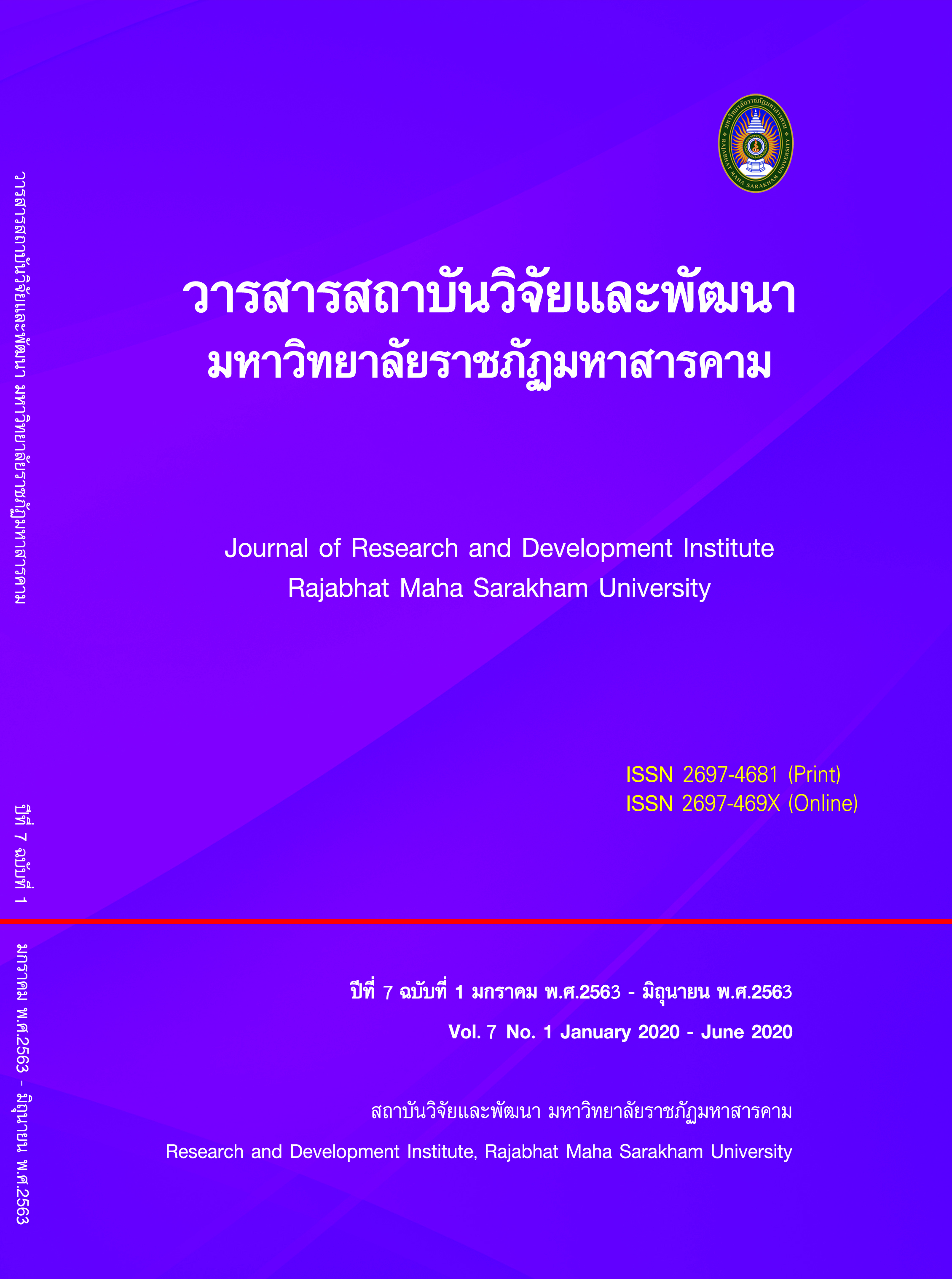แนวทางการพัฒนานักศึกษาภาคปกติตามกรอบมาตรฐานคุณวุฒิระดับอุดมศึกษา มหาวิทยาลัยราชภัฏมหาสารคาม
คำสำคัญ:
แนวทางการพัฒนา, กรอบมาตรฐานระดับอุดมศึกษา, นักศึกษาภาคปกติบทคัดย่อ
การศึกษาวิจัยครั้งนี้ มีวัตถุประสงค์ เพื่อศึกษาระดับสภาพปัจจุบันและสภาพความคาดหวังในการพัฒนานักศึกษาภาคปกติ ตามกรอบมาตรฐานคุณวุฒิระดับอุดมศึกษา มหาวิทยาลัยราชภัฏมหาสารคาม เพื่อศึกษาความต้องการจำเป็นของการพัฒนานักศึกษาภาคปกติตามกรอบมาตรฐานคุณวุฒิระดับอุดมศึกษา และเพื่อศึกษาแนวทางในการพัฒนานักศึกษาภาคปกติตามกรอบมาตรฐานคุณวุฒิระดับอุดมศึกษา กลุ่มตัวอย่าง คือ อาจารย์ประจำมหาวิทยาลัยราชภัฏมหาสารคาม จำนวน 235 คน โดยการใช้สูตรของ ทาโร ยามาเน่ เครื่องมือที่ใช้ในการวิจัยครั้งนี้ ได้แก่ แบบสอบถาม สถิติที่ใช้ในการวิเคราะห์ข้อมูล ได้แก่ ร้อยละ ค่าเฉลี่ย ความถี่ ส่วนเบี่ยงเบนมาตรฐาน และการคำนวณหาค่าความต้องการจำเป็นของการพัฒนานักศึกษาโดยวิธี Modified Priority Need Index (PNI Modified) ผลการวิจัย พบว่า 1) ระดับสภาพปัจจุบันและสภาพความคาดหวังในการพัฒนานักศึกษาภาคปกติ ตามกรอบมาตรฐานคุณวุฒิระดับอุดมศึกษา มหาวิทยาลัยราชภัฏมหาสารคาม โดยรวมอยู่ในระดับมาก 2) ความต้องการจำเป็นของการพัฒนานักศึกษาภาคปกติตามกรอบมาตรฐาน คุณวุฒิระดับอุดมศึกษา โดยมีค่า PNI Modified อยู่ระหว่าง 0.05 ถึง 0.20 โดยภาพรวม (0.10) 3) แนวทางในการพัฒนานักศึกษาภาคปกติตามกรอบมาตรฐานคุณวุฒิระดับอุดมศึกษา ได้แก่ ควรจัดกิจกรรมให้นักศึกษาบำเพ็ญประโยชน์จิตอาสา ควรจัดการเรียนการสอนที่เน้นการใช้ความรู้ในการแก้ปัญหาในสถานการณ์จริง ควรเปิดโอกาสและสนับสนุนให้นักศึกษาจัดกิจกรรมที่สร้างสรรค์ได้อย่างอิสระ ควรสนับสนุนให้นักศึกษาได้แลกเปลี่ยนเรียนรู้ระหว่างกลุ่มหรือคณะ ควรจัดกิจกรรมการคิดวิเคราะห์เพิ่มเติมในการเรียนการสอน และสนับสนุนการใช้ประโยชน์จากเทคโนโลยีที่ทันสมัย เช่น Line Facebook
เอกสารอ้างอิง
References
Apinapus Chitrakorn. (2016). “The Need Assessment for Development of Desired Characteristic of Graduate Students Studying inMaster of Fine Arts Program, Division of Visual Arts Education, Faculty of Painting, Sculpture and Graphic Arts and Faculty of Education, Silpakorn University”. Silpakorn Education Research Journal, 8 (2), 19-35.
Human Resource Management Division, Rajabhat Maha Sarakham University. (2019). Number of personnel, Rajabhat Maha Sarakham University. Mahasarakham: Rajabhat Maha Sarakham University.
Office of the Higher Education Commission. (2008). Framework for the Long-Term 15-Year Higher Education Plan, 2nd Edition (2008 - 2022). [Online] http://www.mua.go.th/users/bpp/developplan/. [20 March 2017]
Office of the Higher Education Commission. (2014). Internal Quality Assurance Manual Higher education level, academic year 2014. Bureau of Higher Education Standards and Quality : Office of the Higher Education Commission.
Pensinee Kitkha. (2016). “An Evaluation of Need Assessment in Desirable Characteristics Development of English Major Students”. Silpakorn Education Research Journal, 8 (2), 62-75.
Rajabhat Institute Office. (1999). Desirable characteristics of graduates, National Qualifications Framework for Higher Education. Mahasarakham: Rajabhat Institute Office.
Ratchadaporn Ketanon Neawheangtham. (2015). “The Needs Assessment to Develop Graduates Desirable of a Graduate Student in Field of Development Education, Faculty of Education, Silpakorn University”. Veridian E-Journal, Slipakorn University, 8 (2), 2204-2216.
Suwimon Wongwanich. (2007). Research needs to be assessed. 2nd edition. Bangkok: Chulalongkorn University.
Ujsara Prasertsin. (2015). “Needs assessment for developing the eight desired characteristics of secondary school students”. Journal of Library and Information Science Srinakharinwirot University, 8 (2), 57-68
Yamane, Taro. (1973). Statistics: An Introductory Analysis. 3rd edition. New York : Harper and Row Publication.
ดาวน์โหลด
เผยแพร่แล้ว
รูปแบบการอ้างอิง
ฉบับ
ประเภทบทความ
สัญญาอนุญาต
บทความที่ได้รับการตีพิมพ์เป็นลิขสิทธิ์เป็นของผู้ประพันธ์บทความ







